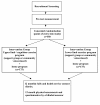Exercise intervention to prevent falls and enhance mobility in community dwellers after stroke: a protocol for a randomised controlled trial
- PMID: 19624858
- PMCID: PMC2719587
- DOI: 10.1186/1471-2377-9-38
Exercise intervention to prevent falls and enhance mobility in community dwellers after stroke: a protocol for a randomised controlled trial
Abstract
Background: Stroke is the most common disabling neurological condition in adults. Falls and poor mobility are major contributors to stroke-related disability. Falls are more frequent and more likely to result in injury among stroke survivors than among the general older population. Currently there is good evidence that exercise can enhance mobility after stroke, yet ongoing exercise programs for general community-based stroke survivors are not routinely available. This randomised controlled trial will investigate whether exercise can reduce fall rates and increase mobility and physical activity levels in stroke survivors.
Methods and design: Three hundred and fifty community dwelling stroke survivors will be recruited. Participants will have no medical contradictions to exercise and be cognitively and physically able to complete the assessments and exercise program. After the completion of the pre-test assessment, participants will be randomly allocated to one of two intervention groups. Both intervention groups will participate in weekly group-based exercises and a home program for twelve months. In the lower limb intervention group, individualised programs of weight-bearing balance and strengthening exercises will be prescribed. The upper limb/cognition group will receive exercises aimed at management and improvement of function of the affected upper limb and cognition carried out in the seated position. The primary outcome measures will be falls (measured with 12 month calendars) and mobility. Secondary outcome measures will be risk of falling, physical activity levels, community participation, quality of life, health service utilisation, upper limb function and cognition.
Discussion: This study aims to establish and evaluate community-based sustainable exercise programs for stroke survivors. We will determine the effects of the exercise programs in preventing falls and enhancing mobility among people following stroke. This program, if found to be effective, has the potential to be implemented within existing community services.
Trial registration: The protocol for this study is registered with the Australian New Zealand Clinical Trials Registry (ACTRN12606000479505).
Similar articles
-
Trial Protocol: Home-based exercise programs to prevent falls and upper limb dysfunction among community-dwelling older people: study protocol for the BEST (Balance Exercise Strength Training) at Home randomised, controlled trial.J Physiother. 2018 Apr;64(2):121. doi: 10.1016/j.jphys.2017.10.001. Epub 2018 Mar 28. J Physiother. 2018. PMID: 29605522 Clinical Trial.
-
Exercise and fall prevention self-management to reduce mobility-related disability and falls after fall-related lower limb fracture in older people: protocol for the RESTORE (Recovery Exercises and STepping On afteR fracturE) randomised controlled trial.BMC Geriatr. 2016 Feb 2;16:34. doi: 10.1186/s12877-016-0206-5. BMC Geriatr. 2016. PMID: 26838998 Free PMC article. Clinical Trial.
-
Minimising disability and falls in older people through a post-hospital exercise program: a protocol for a randomised controlled trial and economic evaluation.BMC Geriatr. 2009 Feb 26;9:8. doi: 10.1186/1471-2318-9-8. BMC Geriatr. 2009. PMID: 19245697 Free PMC article. Clinical Trial.
-
Carer-supported home-based exercises designed to target physical activity levels and functional mobility after stroke: a scoping review.Disabil Rehabil. 2024 Aug;46(17):3760-3771. doi: 10.1080/09638288.2023.2256663. Epub 2023 Sep 12. Disabil Rehabil. 2024. PMID: 37698010
-
Effectiveness of muscle strengthening and description of protocols for preventing falls in the elderly: a systematic review.Braz J Phys Ther. 2014 Mar-Apr;18(2):111-8. doi: 10.1590/s1413-35552012005000148. Epub 2014 Apr 22. Braz J Phys Ther. 2014. PMID: 24760166 Free PMC article.
Cited by
-
Circuit class therapy for improving mobility after stroke.Cochrane Database Syst Rev. 2017 Jun 2;6(6):CD007513. doi: 10.1002/14651858.CD007513.pub3. Cochrane Database Syst Rev. 2017. PMID: 28573757 Free PMC article.
-
Assessing the risk for falls among Portuguese community-dwelling stroke survivors. Are we using the better tools? Observational study.Porto Biomed J. 2022 Jun 17;7(3):e160. doi: 10.1097/j.pbj.0000000000000160. eCollection 2022 May-Jun. Porto Biomed J. 2022. PMID: 35801217 Free PMC article.
-
Physical activity among persons aging with mobility disabilities: shaping a research agenda.J Aging Res. 2011;2011:708510. doi: 10.4061/2011/708510. Epub 2011 Jun 26. J Aging Res. 2011. PMID: 21748010 Free PMC article.
-
Interventions for preventing falls in people after stroke.Cochrane Database Syst Rev. 2019 Oct 1;10(10):CD008728. doi: 10.1002/14651858.CD008728.pub3. Cochrane Database Syst Rev. 2019. PMID: 31573069 Free PMC article. Review.
-
Interventions to improve outdoor mobility among people living with disabilities: A systematic review.Campbell Syst Rev. 2024 Jun 14;20(2):e1407. doi: 10.1002/cl2.1407. eCollection 2024 Jun. Campbell Syst Rev. 2024. PMID: 38882933 Free PMC article. Review.
References
-
- American Heart Association . Heart Disease and Stroke Statistics 2009 Update. Dallas Tx: American Heart Association; 2009. http://www.americanheart.org/downloadable/heart/1240250946756LS-1982%20H...
-
- Hill K, Ellis P, Bernhardt J, Maggs P, Hull S. Balance and mobility outcomes for stroke patients: a comprehensive audit. Aust J of Physio. 1997;43:173–180. - PubMed
Publication types
MeSH terms
LinkOut - more resources
Full Text Sources
Medical


